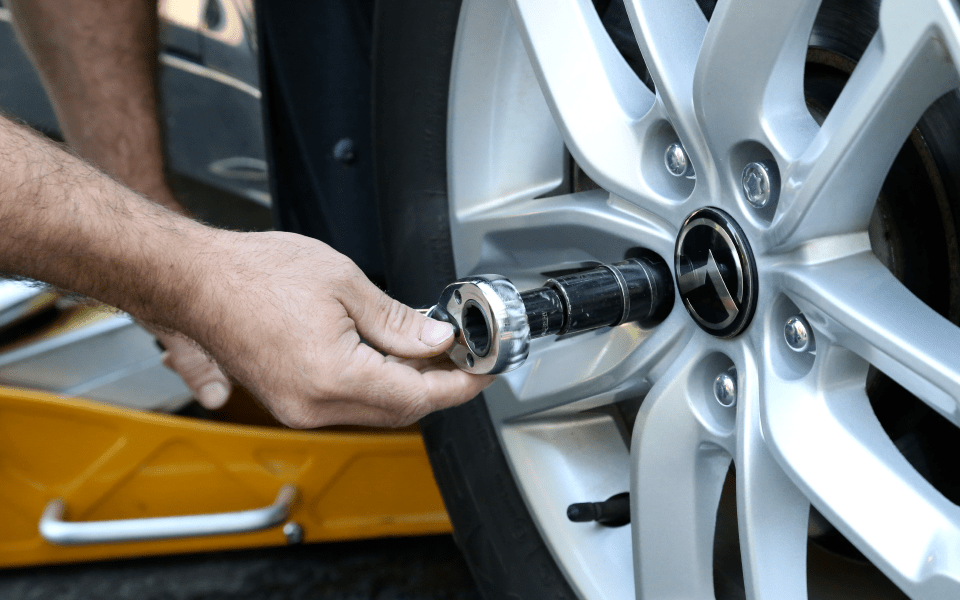When a manufacturer creates a tire or wheel, no two are ever exactly alike. That means they are different weights — even if it’s by a fraction of an ounce. Those small differences can cause issues, which is why we balance the wheel-tire assemblies on every vehicle we service. But how do you know if your tires and wheels need to be rebalanced? We have some quick tips.
Tire balancing is a tune-up for each of your wheel-tire assemblies. Balancing helps ensure weight is evenly distributed around the entire circumference of the tire and wheel. Balancing a wheel-tire assembly is done with small weights.
The common symptoms of an out-of-balance wheel-tire assembly are uneven and faster tread wear, poor fuel economy, or vibration in the steering wheel and/or floorboard that gets worse at faster speeds. When all areas of the wheel-tire assembly are as equal in weight as possible, the tire will roll smoothly.
This helps improve tread wear. Balancing also contributes to overall ride comfort.
Imbalanced tires can wobble or hop up and down, causing vibration. If a front tire isn’t properly balanced, you’ll likely feel vibration in the steering wheel. If the problem is in the rear, you’ll feel shaking in the seat or floor.
Everyday wear on tires and wheels can cause an imbalance. Plus, if a wheel weight comes off, if you hit a curb or pothole, or if you get a flat repaired, your wheel-tire assembly can get out of balance.
When a wheel-tire assembly is especially out-of-balance, you’ll likely know it right away. You’ll feel it in the steering wheel or floorboards. A thump-thump-thump sound that gets louder at lower or higher speeds might also be an indicator. Here are a few signs that you should get yours rebalanced.
You might need an alignment, or your tires and wheels are out of balance. Les Schwab has the expertise to check your vehicle, make recommendations, and get you back on the road.
Les Schwab has the expertise to check your vehicle, make recommendations, and get you back on the road.
If the tread on your tires appears to wear too quickly, it could be an out-of-balance wheel-tire assembly.
Vibration in the steering wheel when driving could be caused by an out-of-balance wheel-tire assembly. It could also be a bent wheel, a damaged tire (which won’t be fixed by balancing), worn suspension parts or other aging components. If you feel a vibration, don’t wait. Get to Les Schwab and let our pros take a look.
It’s advisable to get your wheel-tire assemblies balanced with every tire rotation. Additionally, anytime you get new tires, balancing should be part of the new-tire package. Other times to consider rebalancing include when you hit a curb, pothole, or other debris that breaks off or damages a balance weight, if you get a flat repaired, or anytime you notice uneven tread wear and vibrations.
At Les Schwab, tire balancing and rotation are done at the same time. However, they aren’t the same service. Tire rotation is when a vehicle’s front and rear wheels are switched to even out tread wear. Since both require removing each wheel, it’s convenient to do them at the same time.
Les Schwab Tip: Do you leave your car or truck parked in one spot for months at a time? Flat spots could develop in the tires, causing balance issues. This can go away after a few miles of driving. But if not, stop by Les Schwab.
Rebalancing is done in a tire shop by putting the wheel-tire unit on a tire balancing machine that takes measurements to pinpoint lighter or heavier areas. Adjustments are then made to account for these weight differences. The best time to get it done is when tires are being rotated, both for convenience and because you might have a tire out of balance on the rear of the vehicle and won’t feel it until it is moved to the front.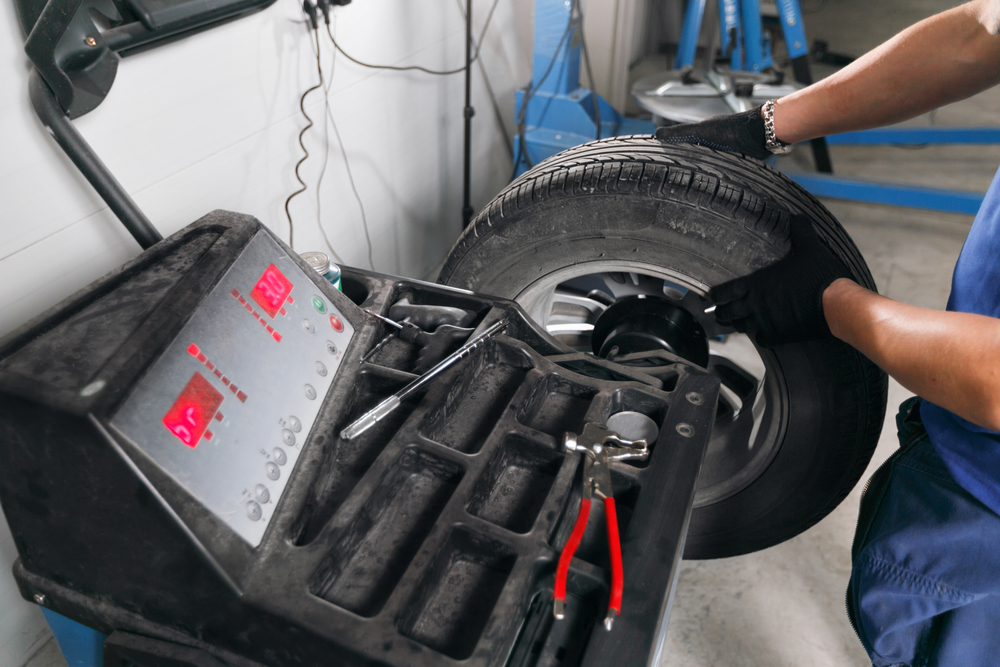
Here’s how it’s done:
A tire mounted on a wheel is attached to a tire balancing machine.
The wheel is spun while vibration measurements are taken. This tells the tech if the weight is spread evenly, how much weight to add and where on the wheel to attach it.
If an imbalance is found, the technician may be able to rebalance and adjust the weights (adding more). But sometimes it requires the tech to also reposition the tire on the wheel and then rebalance. This is because a heavy spot on the wheel and on the tire can sometimes line up together, causing a greater imbalance that needs to be corrected.
Though both should be part of regular auto maintenance, balancing isn’t the same as getting an alignment. Wheel alignment corrects the angles of the tires so they travel in the same direction and properly make contact with the road. Alignment reduces uneven tire wear and extends the life of your tires.
Alignment reduces uneven tire wear and extends the life of your tires.
The benefits of a balanced wheel-tire assembly include a smoother ride, as well as money saving benefits such as less tread wear, better gas mileage, and less strain on many parts of your vehicle.
Properly balanced wheel-tire assemblies can add up to more tread life, increased fuel economy, and less wear and tear on your vehicle. Les Schwab has the tools and know-how to get yours done right. If you have a set of Les Schwab tires, come on by and we’ll rebalance them for free. It’s part of our Best Tire Value Promise. Didn’t buy your tires here? We’ll be happy to take a look, give you an estimate, and get the job done right.
Your tire’s “balance” is the weight distribution in each wheel or tire of a vehicle.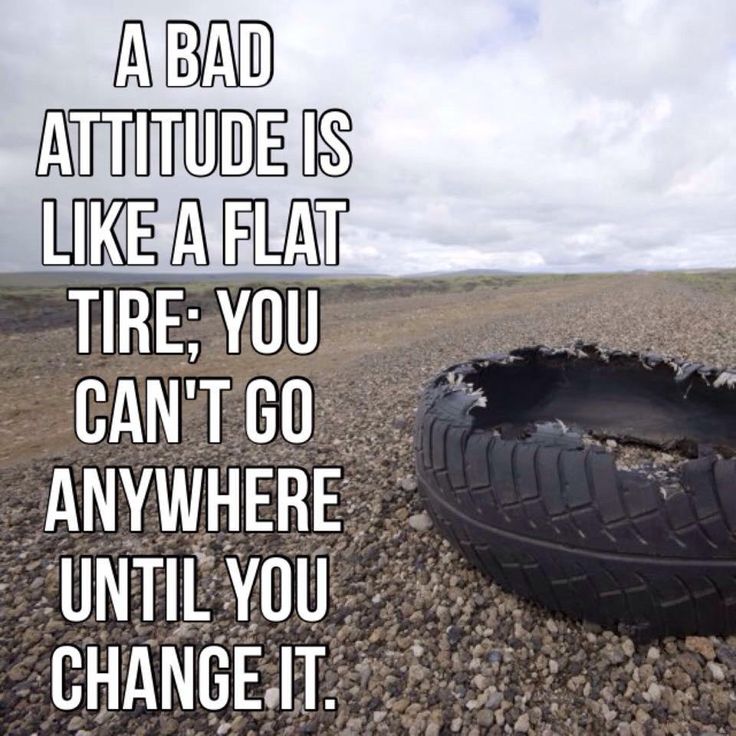 If the balance of your tires is off, you will start to notice a vibration or wobble at higher speeds. If the wobble is particularly pronounced, it can become dangerous and any vibration through the tires will increase the rate at which they wear. So what causes unbalanced tires and how often should you have them rebalanced?
If the balance of your tires is off, you will start to notice a vibration or wobble at higher speeds. If the wobble is particularly pronounced, it can become dangerous and any vibration through the tires will increase the rate at which they wear. So what causes unbalanced tires and how often should you have them rebalanced?
The leading cause of unbalanced tires is simple wear and tear, but it’s not the only possible reason that your tired might become unbalanced. Driving with poor tire alignment can cause your tires to become unbalanced, as can damaged wheels or bent rims. Unless all four tires are unbalanced, you can normally identify where the imbalance is by where the vibration is coming from. If the front tires are imbalanced, then the vibration will be in the steering wheel. If the rear tires are unbalanced, then you will feel the vibration through your seat, particularly if you sat in the back.
The vibration, or wobble, from unbalanced tires will grow over time to the point where it can make your car difficult to steer properly, potentially causing an accident. The vibration from unbalanced tires can also damage your car. Your tires will wear down faster and, if the problem is allowed to continue, it will eventually damage your shocks, bearings and even the entire wheel assembly. This damage is not only dangerous, it can be very costly to fix in the long run.
The vibration from unbalanced tires can also damage your car. Your tires will wear down faster and, if the problem is allowed to continue, it will eventually damage your shocks, bearings and even the entire wheel assembly. This damage is not only dangerous, it can be very costly to fix in the long run.
If you notice any of the symptoms of unbalanced tires you should take steps to rectify the situation immediately. Not doing so could put you and your passengers at risk. The best way to avoid this risk is to prevent the situation from happening in the first place. A good rule of thumb is that your tires should be rebalanced every 12,000 miles driven or every other time your tires are rotated. Having your tires rebalanced as part of tire rotation is a quick and easy process that could save you from costly repairs in the future.
Northwest Driving School and Traffic School provides the Las Vegas community with live driving and traffic classes taught by seasoned instructors. All of our driving instructors have passed background checks, each automobile is DMV safety-approved and every member of the Northwest family is committed to providing excellent drivers ed and behind the wheel instruction.
All of our driving instructors have passed background checks, each automobile is DMV safety-approved and every member of the Northwest family is committed to providing excellent drivers ed and behind the wheel instruction.
At Northwest, you can expect to find outstanding classes, both on campus and behind the wheel, that are engaging, fact-filled, entertaining and geared toward success. We make no bones about it, we believe that Northwest provides the best driving lessons in Las Vegas, no matter your age or background. We are proud of the fact that 98% of our students pass their test on the first try. Call us at (702) 403-1592 to start your driving adventure with one of our expert instructors.
Written by:
Rich Heinrich
Master Instructor, Emeritus
Lada
UAZ
KIA
Hyundai
Renault
Toyota
Volkswagen
Skoda
BMC
BMC
BMC
BM
Mitsubishi
Mazda
Ford
All brands
Related materials
Seasonal tire change: everything car owners need to know
To begin with, a small educational program.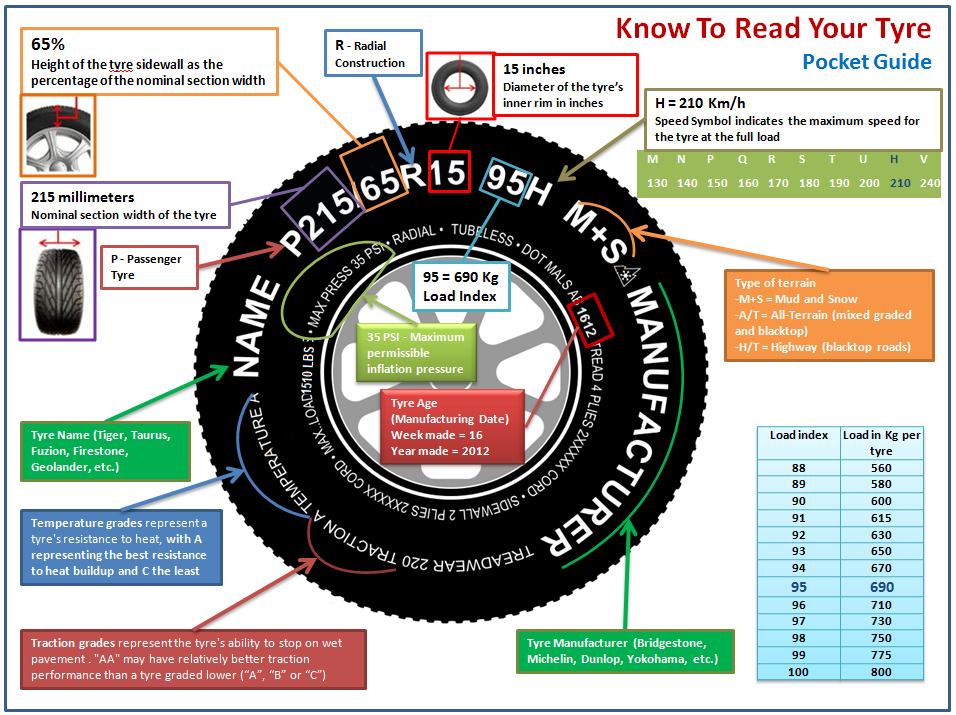 Balancing is the alignment of the center of mass of the wheel with the axis of rotation. In this case, the loads are fixed opposite the heavy part of the wheel. This is the definition of static balancing. And since the wheel is not a thin disk, but rather a wide roller, the so-called dynamic balancing is necessary, when loads are placed both on the outer and on the inner parts of the wheel disk. Naturally, the wheels need to be balanced immediately after mounting the tire on the rim: after all, the imbalance can reach 50–60 g on each side. If it turns out more, then it makes sense to "twist" the tire relative to the disk, ensuring their mutual rotation by 180 degrees. With this initial balancing, tire workers provide an imbalance of less than 5 g per side. It is believed that a new tire is capable of slightly changing its position on the disk in the first kilometers, and therefore the balancing will go away a little.
Balancing is the alignment of the center of mass of the wheel with the axis of rotation. In this case, the loads are fixed opposite the heavy part of the wheel. This is the definition of static balancing. And since the wheel is not a thin disk, but rather a wide roller, the so-called dynamic balancing is necessary, when loads are placed both on the outer and on the inner parts of the wheel disk. Naturally, the wheels need to be balanced immediately after mounting the tire on the rim: after all, the imbalance can reach 50–60 g on each side. If it turns out more, then it makes sense to "twist" the tire relative to the disk, ensuring their mutual rotation by 180 degrees. With this initial balancing, tire workers provide an imbalance of less than 5 g per side. It is believed that a new tire is capable of slightly changing its position on the disk in the first kilometers, and therefore the balancing will go away a little.
Now let's turn directly to our topic. If you alternately install either winter or summer tires on the same wheels, then you cannot avoid balancing. There is nothing to argue about here. The question of balancing every season arises only for those car owners who have two complete sets of wheels: summer and winter.
There is nothing to argue about here. The question of balancing every season arises only for those car owners who have two complete sets of wheels: summer and winter.
Related materials
Routine work that everyone ignores (and in vain!)
So, should the wheels be balanced at every seasonal change?
If you approach the process formally, then you should remember the instructions for the car. It is usually recommended to balance the wheels after a run of 10,000 to 15,000 km. If you drive less in one season, then you definitely shouldn’t balance, except for the cases specified below.
But this is in theory, but in practice I advise you to monitor the behavior of the car. If there is no noticeable beating of the steering wheel, then balancing is not needed. The beating of the rear wheels is felt less, but they usually suffer less often. In any case, you should feel a strong imbalance.
If you change your own wheels twice a year, the following recommendation applies. Put the wheels on and ride for a couple of days. During this time, the tire will get rid of the deformations that occurred during storage. If there are no vibrations at any speed with which you drive, balancing can not be carried out.
Put the wheels on and ride for a couple of days. During this time, the tire will get rid of the deformations that occurred during storage. If there are no vibrations at any speed with which you drive, balancing can not be carried out.
Related materials
10 procedures without which it is better not to drive
Balancing is required in the following cases:
Photo: depositphotos.com
Our new video
New Vesta — how much will it cost?
3 interesting features of the updated Vesta.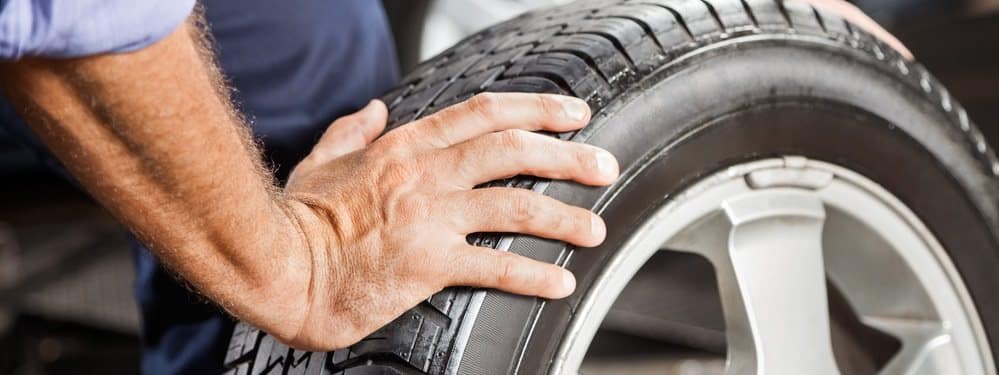 And 2 more - in the future
And 2 more - in the future
Updated Lada Vesta NG: what is the package?
Did you like the note? Subscribe and you will always be in the know!
Driving in Zen
Lack of wheel balance is not only a deferred suspension expense and premature tire wear, but also a potential threat to safe driving. Wheel wobble leads to uneven "eating" of the tire, vibrations on the steering wheel, which are more felt with increasing speed.
However, once done balancing is not something eternal. Poor road surface, long-term storage, errors in operation lead to wheel imbalance. Winter and summer tires on two sets of discs do not save here.
Regardless of the operating options, the answer here is unambiguous: yes, balancing is needed.
Consider the option with two sets of rubber on the disks.
After leaving the winter, the driver sends the winter set for storage in the garage or on the balcony. The wheels will only return to the car closer to the next first snow. During the operation, the wheel with a high degree of probability flew into the pit more than once, it is possible that the tire was not inflated in time, it was operated in modes not intended for it. All this can lead to loss of weights, a slight change in tire weight, but enough to upset the balance of the wheel.
The wheels will only return to the car closer to the next first snow. During the operation, the wheel with a high degree of probability flew into the pit more than once, it is possible that the tire was not inflated in time, it was operated in modes not intended for it. All this can lead to loss of weights, a slight change in tire weight, but enough to upset the balance of the wheel.
Tire manufacturers recommend balancing every 10-15 thousand km. Each driver has his own driving mode, so these recommendations are quite difficult to follow. It is better to check and balance before the start of the season.
At the expense of winter studded tires, there is a special opinion that the mileage until the next check is 5 thousand km. The reason is the flying spikes and increased loads on the wheel, which are formed due to adhering ice.
It is also recommended to balance after a puncture or cut has been repaired, after a serious blow.
The quality of work is influenced, first of all, by the equipment.